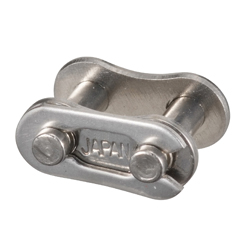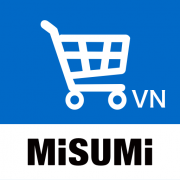(!) Since support from Microsoft will end on January 14th, 2020, Windows 7 will be excluded from the recommended environment from December 15th, 2019 on this site. Vì lý do Microsoft kết thúc hỗ trợ cho Windows 7 vào ngày 14/01/2020, Windows 7 sẽ là hệ điều hành không được khuyến khích sử dụng với trang web này từ ngày 15/12/2019.
Search by Category / Brand Tìm theo danh mục, nhãn hiệu
Search by Category Tìm theo danh mục
- [Thông báo] Cập nhật địa chỉ kho tập kết hàng hóa tại khu vực miền Nam của MISUMI Việt Nam. Xem chi tiết.
[Announcement] Update on warehouse address in the Southern region of MISUIMI Vietnam. See more. - [Cảnh Báo] Thủ Đoạn Lừa Đảo Từ Nhân Viên Giao Hàng – Yêu Cầu Trả Phí Ship. Xem chi tiết.
[Warning] Fraud Calling from Shipper - Asking to Pay Shipping Fee. See more.
Roller Chains(Nominal Number:25-SUS)
|
Type
|
|
|---|---|
Brand |
|
| CAD |
|
| Days to Ship |
|
1 itemsMặt hàng
- Sort By
-
You can add up to 6 items per a category to the compare list.

KATAYAMA CHAIN
[Features]・ All parts of the stainless steel chain are made of SUS304.・ It can be used in places where it is exposed to chemical corrosion such as acidity and alkalinity, water or steam, and in high and low temperature atmospheres
Type Nominal Number Pitch Number of Strands Material Surface Treatment Max. Allowable Tension(kN) Standard Chains 25-SUS - - Stainless Steel - - From: 61,238 VND Days to Ship: Số ngày giao hàng: 6 Day(s) or more  6 Day(s) or more
6 Day(s) or more
| BrandNhãn hiệu |
|---|
| Product SeriesDòng sản phẩm |
| CADCAD |
| From |
| Days to ShipSố ngày giao hàng |
| Type |
| Nominal Number |
| Pitch |
| Number of Strands |
| Material |
| Surface Treatment |
| Max. Allowable Tension(kN) |
You can add up to 6 items per a category to the compare list. | |
| BrandNhãn hiệu | KATAYAMA CHAIN |
| Product SeriesDòng sản phẩm | |
| CADCAD |
|
| From | 61,238 VND |
| Days to ShipSố ngày giao hàng | 6 Day(s) or more |
| Type | Standard Chains |
| Nominal Number | 25-SUS |
| Pitch | - |
| Number of Strands | - |
| Material | Stainless Steel |
| Surface Treatment | - |
| Max. Allowable Tension(kN) | - |
Loading...Tải…
ConfigureTạo
Specification/DimensionsĐặc điểm kỹ thuật / Kích thướcĐặc điểm kỹ thuật / Kích thước
-
Nominal Number
- 06B
- 08B
- 10B
- 11
- 12B
- 15
- 16B
- 20B
- 25
- 25-N
- 25-SUS
- 35
- 35-N
- 35-SUS
- 35(R)
- 40
- 40-N
- 40-SUS
- 40F
- 40F-SUS
- 40H
- 40HP
- 40HP-SUS
- 40NL
- 40SB
- KANA40-SUS
- TYC40
- 50
- 50-N
- 50-SUS
- 50F
- 50F-SUS
- 50H
- 50HP
- 50HP-SUS
- 50NL
- 50SB
- KANA50-SUS
- TYC50
- 60
- 60-N
- 60-SUS
- 60F
- 60F-SUS
- 60H
- 60HP
- 60HP-SUS
- 60NL
- 60SB
- KANA60-SUS
- TYC60
- 80
- 80-N
- 80-RPSUS
- 80F
- 80FS-TS
- 80H
- 80NL
- KANA80-SUS
- TYC80
- 100
- 100F
- 100H
- SS100(R)
- 120
- 120(R)
- 140
- 160
- 200
- 410
- 415
- 415S
- 420
- C2040HP
- C2040HP-SUS
- C2050HP
- C2050HP-SUS
- C2060HP
- C2060HP-SUS
-
Pitch
-
Number of Strands
- 1
- 2
- 3
- 4
-
Material
- Steel
- Stainless Steel
-
Surface Treatment
- Special Anti-corrosion Treatment
- Not Provided
-
Max. Allowable Tension(kN)
- ~99
- 100~499
Application example related to this categoryVí dụ ứng dụng liên quan đến danh mục này
Related Categories to Roller ChainsDanh mục liên quan đến Roller Chains
FAQ Roller Chains
- Question: How can I determine the right Roller Chains size and type for my application?
- Answer: To determine the right Roller Chains size and type for your application, you need to consider factors such as load capacity, operating conditions, speed, and type of motion required. It is essential to consult the manufacturer's specifications and guidelines to ensure that the Roller Chains meets your application's requirements.
- Question: How do I maintain and prolong the lifespan of my Roller Chains?
- Answer: Maintaining and prolonging the lifespan of your Roller Chains involves regular inspection and lubrication. You should inspect your chains regularly for signs of wear or damage, and address any issues promptly to prevent further damage to the chain or equipment. Lubrication is also critical to reduce friction and wear on the chain, and you should use the appropriate lubricant according to the manufacturer's specifications.
- Question: What variety of materials does Roller Chains products offer for its chains, and how do these materials cater to different applications and user preferences?
- Answer: Roller Chains Products offer a range of materials for its chains, including steel, stainless steel, plastic, and specialized materials for high-temperature or corrosive environments. Each material has its unique properties and advantages that cater to different applications and user preferences. For instance, stainless steel chains offer superior corrosion resistance, while plastic chains are lightweight and provide excellent chemical resistance.
- Question: What types of surface treatments does Roller Chains Products have and how different?
- Answer: Roller Chains Products offer a variety of surface treatments for its chains, including coatings, plating, and heat treatment. These treatments provide additional protection against corrosion, wear, and other types of damage. Some common surface treatments include nickel plating, zinc plating, and black oxide coating. The choice of surface treatment depends on the specific application and user requirements.












How can we improve?
How can we improve?
While we are not able to respond directly to comments submitted in this form, the information will be reviewed for future improvement.
Customer Privacy Policy
Thank you for your cooperation.
While we are not able to respond directly to comments submitted in this form, the information will be reviewed for future improvement.
Please use the inquiry form.
Customer Privacy Policy